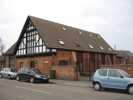 Newark Newark
St Augustine
Archaeology
The building is constructed of brick and was built entirely anew in 1886 and enlarged by 1912. Prior to construction the site was a field fronting onto Barnby Gate, there is no evidence of any former use for the site other than agricultural.
The church was of simple plan, nave and polygonal apsidal chancel, no tower, and was constructed of red brick with a half timbered gable on the west side. Until the 1970s there had been a bell turret above the vestry.
It was converted into domestic use in the late 1990s.
Technical Summary
Timbers and roofs
|
NAVE |
CHANCEL |
TOWER |
| Main |
Pitched, principal rafters to moulded brackets, iron ties at two levels, inverted 'V' braces to ties from collars. All 1886. |
Apsidal roof with simple principal rafter supports. All 1886. |
n/a |
| S.Aisle |
n/a |
n/a |
|
| N.Aisle |
n/a |
n/a |
|
| Other principal |
|
|
|
| Other timbers |
|
|
|
Bellframe
No bell or bellframe.
Walls
|
NAVE |
CHANCEL |
TOWER |
| Plaster covering & date |
Plastered and painted 1886 and later, now modern replastering. |
Plastered and painted 1886 and later, now modern replastering. |
n/a |
| Potential for wall paintings |
Unknown. Evidence probably now destroyed. |
Unknown. Evidence probably now destroyed. |
n/a |
Excavations and potential for survival of below-ground archaeology
There have been no known archaeological excavations.
The fabric of the entire building dates to 1886. Prior to construction the land was open field space.
The churchyard is small and irregular, with the church positioned centrally. There are no burials.
The overall potential for the survival of below-ground archaeology in the churchyard is considered to be LOW comprising evidence from the 1886 and late C20th building phases and unlikely to have any other significant deposits. Below the present interior floors of the church it is considered to be LOW comprising mainly stratigraphy from the 1886 and late C20th construction. The archaeology of the upstanding fabric in the body of the church was largely of a single period, 1886, although the late C20th conversion has entailed considerable internal alterations; its archaeological potential as representative of this date is LOW.
Exterior: No burials, 1886 and late C20th construction evidence only likely.
Interior: Stratigraphy almost exclusively 1886 and late C20th.
|